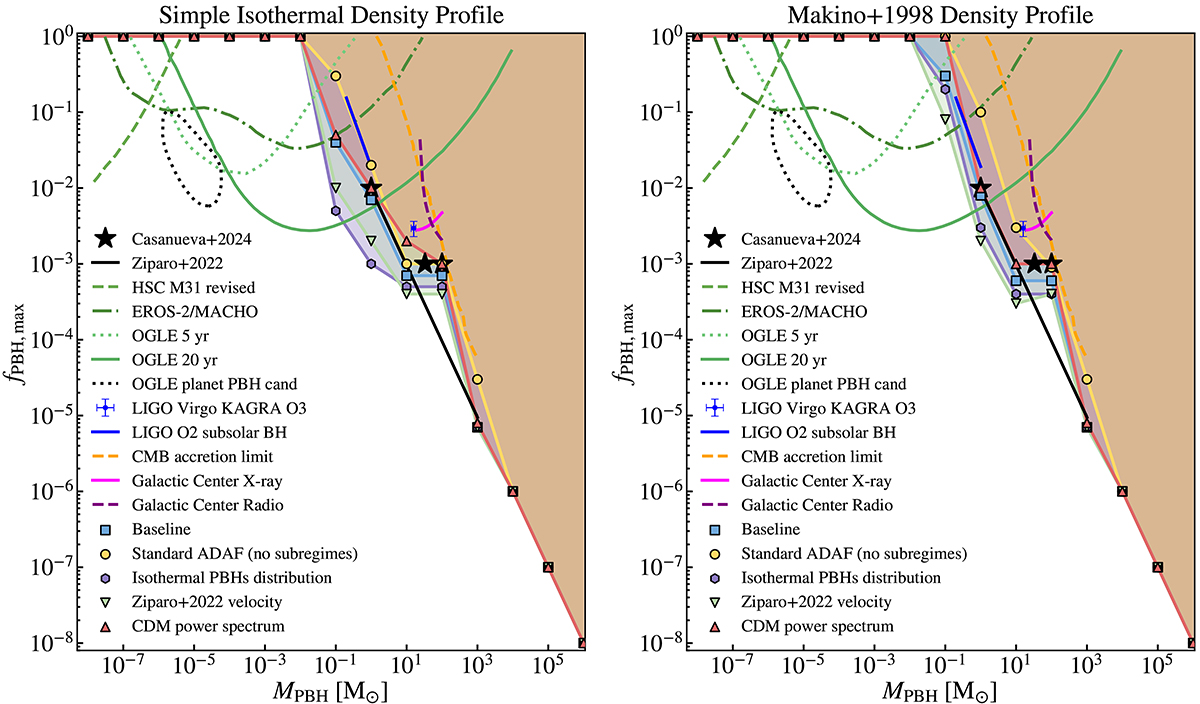Fig. 7.

Download original image
Constraints on the maximum allowed PBH DM fraction for different monochromatic PBH masses, including results derived in this work under various modelling assumptions, as well as observational limits and previous theoretical results. We consider two gas density profiles within halos: a simple isothermal (left panel) and the Makino+1998 profile (right panel). For each case, we compute the allowed PBH abundance under different modelling scenarios: baseline (blue squares), standard ADAF without subregimes (yellow circles), isothermal PBH spatial distribution (purple hexagons), Ziparo+2022 velocity prescription (green downward triangles), and CDM power spectrum (red upward triangles). Maximum fractions are computed at one-decade intervals in mass across the range 10−8 M⊙ to 106 M⊙. Each coloured marker with a black edge corresponds to the maximum allowed PBH fraction obtained by applying the constraint methodology developed in this work, under a specific model variation. Solid lines connecting the markers and shaded regions, all shown in the same colour as their corresponding markers, are included to aid visual interpretation: although intermediate values were not explicitly computed, the region above each evaluated point can be reliably considered excluded under the corresponding assumptions. In both panels, our constraints are compared with observational limits, with the results from (solid black line; Ziparo et al. 2022), which represent independent theoretical bounds derived from modelling PBH emission contributing to the cosmic X-ray background using a different formalism, and with the results from CV2024 (black stars). While all other constraints correspond to upper bounds on fPBH, the CV2024 markers indicate fractions for which significant PBH-induced feedback effects are already present in the gas within halos at z ∼ 23. Observational constraints, all derived assuming a monochromatic PBH mass function, include microlensing limits from the Subaru M31 survey (Niikura et al. 2019a) updated by Kusenko et al. (2020), green dashed line), from the Expérience pour la Recherche d’Objets Sombres/MAssive Compact Halo Objects (EROS-2/MACHO) (Tisserand et al. 2007, green dot-dashed line), from the OGLE 5 yr survey (Niikura et al. 2019b, dotted green line), and from the OGLE 20 yr survey (Mróz et al. 2024, solid green line). A dotted black line shows the 95% confidence region assuming the six ultrashort-timescale OGLE events are due to planetary-mass PBHs (Niikura et al. 2019b). Additional constraints include the PBH fraction inferred under the assumption that all BH mergers detected during the third observing run (O3) of the LIGO-Virgo-KAGRA Collaboration originate from PBHs (Wong et al. 2021, blue point with error bars), subsolar-mass PBH binary merger limits from LIGO O2 (Abbott et al. 2019, solid blue line), cmB accretion limits from Poulin et al. (2017, orange dashed line), and Galactic Centre constraints from X-ray (magenta solid) and radio (purple dashed) observations (Manshanden et al. 2019).
Current usage metrics show cumulative count of Article Views (full-text article views including HTML views, PDF and ePub downloads, according to the available data) and Abstracts Views on Vision4Press platform.
Data correspond to usage on the plateform after 2015. The current usage metrics is available 48-96 hours after online publication and is updated daily on week days.
Initial download of the metrics may take a while.


